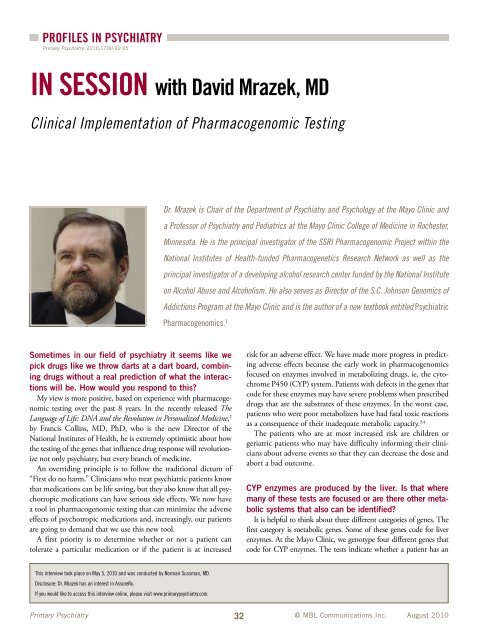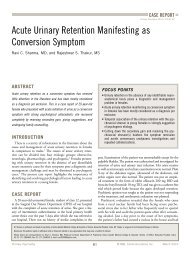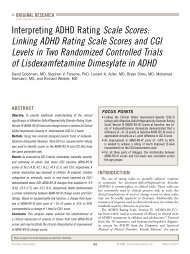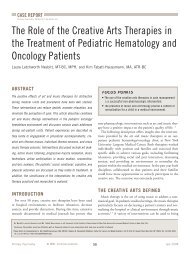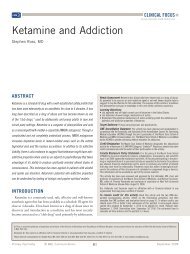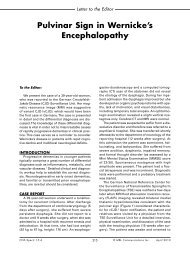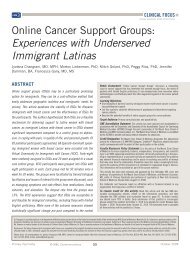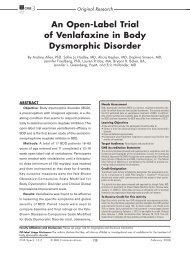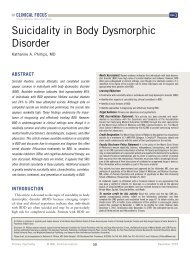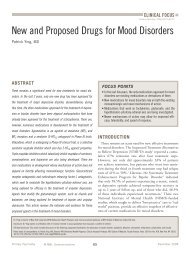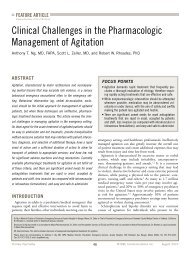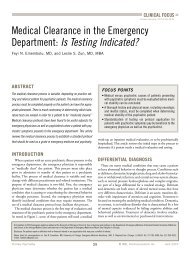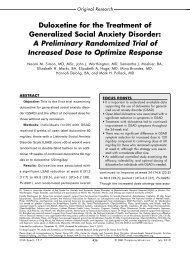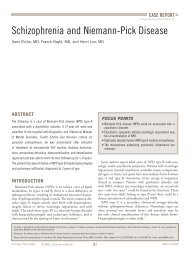IN SESSION with David Mrazek, MD - MBL Communications
IN SESSION with David Mrazek, MD - MBL Communications
IN SESSION with David Mrazek, MD - MBL Communications
Create successful ePaper yourself
Turn your PDF publications into a flip-book with our unique Google optimized e-Paper software.
PROFILES <strong>IN</strong> PSYCHIATRY<br />
Primary Psychiatry. 2010;17(8):32-35<br />
<strong>IN</strong> <strong>SESSION</strong> <strong>with</strong> <strong>David</strong> <strong>Mrazek</strong>, <strong>MD</strong><br />
Clinical Implementation of Pharmacogenomic Testing<br />
Sometimes in our field of psychiatry it seems like we<br />
pick drugs like we throw darts at a dart board, combining<br />
drugs <strong>with</strong>out a real prediction of what the interactions<br />
will be. How would you respond to this?<br />
My view is more positive, based on experience <strong>with</strong> pharmacogenomic<br />
testing over the past 8 years. In the recently released The<br />
Language of Life: DNA and the Revolution in Personalized Medicine, 2<br />
by Francis Collins, <strong>MD</strong>, PhD, who is the new Director of the<br />
National Institutes of Health, he is extremely optimistic about how<br />
the testing of the genes that influence drug response will revolutionize<br />
not only psychiatry, but every branch of medicine.<br />
An overriding principle is to follow the traditional dictum of<br />
“First do no harm.” Clinicians who treat psychiatric patients know<br />
that medications can be life saving, but they also know that all psychotropic<br />
medications can have serious side effects. We now have<br />
a tool in pharmacogenomic testing that can minimize the adverse<br />
effects of psychotropic medications and, increasingly, our patients<br />
are going to demand that we use this new tool.<br />
A first priority is to determine whether or not a patient can<br />
tolerate a particular medication or if the patient is at increased<br />
Primary Psychiatry<br />
Dr. <strong>Mrazek</strong> is Chair of the Department of Psychiatry and Psychology at the Mayo Clinic and<br />
a Professor of Psychiatry and Pediatrics at the Mayo Clinic College of Medicine in Rochester,<br />
Minnesota. He is the principal investigator of the SSRI Pharmacogenomic Project <strong>with</strong>in the<br />
National Institutes of Health-funded Pharmacogenetics Research Network as well as the<br />
principal investigator of a developing alcohol research center funded by the National Institute<br />
on Alcohol Abuse and Alcoholism. He also serves as Director of the S.C. Johnson Genomics of<br />
Addictions Program at the Mayo Clinic and is the author of a new textbook entitled Psychiatric<br />
Pharmacogenomics. 1<br />
This interview took place on May 5, 2010 and was conducted by Norman Sussman, <strong>MD</strong>.<br />
Disclosure: Dr. <strong>Mrazek</strong> has an interest in AssureRx.<br />
If you would like to access this interview online, please visit www.primarypsychiatry.com.<br />
32<br />
risk for an adverse effect. We have made more progress in predicting<br />
adverse effects because the early work in pharmacogenomics<br />
focused on enzymes involved in metabolizing drugs, ie, the cytochrome<br />
P450 (CYP) system. Patients <strong>with</strong> defects in the genes that<br />
code for these enzymes may have severe problems when prescribed<br />
drugs that are the substrates of these enzymes. In the worst case,<br />
patients who were poor metabolizers have had fatal toxic reactions<br />
as a consequence of their inadequate metabolic capacity. 3,4<br />
The patients who are at most increased risk are children or<br />
geriatric patients who may have difficulty informing their clinicians<br />
about adverse events so that they can decrease the dose and<br />
abort a bad outcome.<br />
CYP enzymes are produced by the liver. Is that where<br />
many of these tests are focused or are there other metabolic<br />
systems that also can be identified?<br />
It is helpful to think about three different categories of genes. The<br />
first category is metabolic genes. Some of these genes code for liver<br />
enzymes. At the Mayo Clinic, we genotype four different genes that<br />
code for CYP enzymes. The tests indicate whether a patient has an<br />
© <strong>MBL</strong> <strong>Communications</strong> Inc. August 2010
adequate amount of each particular enzyme <strong>with</strong>in their system. The<br />
second category includes genes such as catechol-O-methyltransferase<br />
(COMT). COMT is involved <strong>with</strong> the catabolism of monoamines.<br />
Testing for COMT gives us some idea about the likelihood of an<br />
individual having a therapeutic response to some psychotropic medications.<br />
The third category is receptor and transporter genes. Progress<br />
in testing for variations in these genes is increasingly exciting. We are<br />
not as far along in understanding all of the clinical implications of<br />
variability in these genes, but for the serotonin transporter gene and<br />
for some of the serotonin receptor genes, we do know that there are<br />
associations <strong>with</strong> medication response. At the Mayo Clinic, we genotype<br />
the serotonin transporter gene (SLC6A4) as well as the serotonin<br />
(5-HT) 2A and 5-HT 2C receptor genes.<br />
Are certain classes of drugs more often implicated in creating<br />
problems <strong>with</strong> respect to interactions or tolerability?<br />
That is an important question because it really focuses on the importance<br />
of understanding the pharmacology of each drug. Psychotropic<br />
drugs in each class are sometimes considered to be equivalent. This<br />
leads to the dart board mentality that you described. However, two<br />
very widely used selective serotonin reuptake inhibitors (SSRIs), paroxetine<br />
and citalopram, have very different mechanisms of metabolism.<br />
Paroxetine is particularly interesting, because of all of the SSRIs,<br />
it has the most exclusive pattern of metabolism. For the average person<br />
<strong>with</strong> adequate CYP 2D6 enzymes, almost the entire metabolism<br />
of paroxetine is through the 2D6 pathway. Approximately 10% of<br />
our patients who are of European ancestry do not have adequate levels<br />
of the CYP 2D6 enzyme, because they have a genetic defect in one<br />
or both of their 2D6 genes. Consequently, they are unable to tolerate<br />
standard doses of paroxetine. In contrast, patients <strong>with</strong> an inadequate<br />
CYP 2D6 enzyme, but who have adequate CYP 2C19 enzymes,<br />
would have no trouble metabolizing citalopram. The adequacy of<br />
both the 2D6 and 2C19 enzymes provides useful information for<br />
some patients about that initial selection of an SSRI.<br />
You referred to patients of European ancestry. Would<br />
Asian patients react to drugs differently?<br />
This is a critical concept that has been increasingly well-studied<br />
over the past decade. All of the CYP genes show variability that is<br />
specific to ancestral origin. The contrasts are often most dramatic<br />
between Asian and European populations. In the case of one of the<br />
most commonly genotyped genes, CYP 2C19, the incidence of inadequate<br />
metabolism is more than twice as great in Japanese populations<br />
when compared to Norwegian populations.<br />
What is the most effective way to educate clinicians<br />
about all of these different gene variations?<br />
That has been a very important issue for me personally<br />
because we have had to do an enormous amount of professional<br />
education related to this complicated topic of genomic variabil-<br />
Primary Psychiatry<br />
33<br />
Profiles in Psychiatry<br />
ity. In 2000, the Mayo Clinic received a large gift from one of<br />
our patients to help us work <strong>with</strong> all our colleagues, both in psychiatry<br />
as well as other medical disciplines, to get our physician<br />
workforce up to speed in individualized molecular medicine.<br />
Clinicians learn by “doing” much more effectively than by listening.<br />
In 2003, we started testing for variability in the CYP 2D6<br />
gene. We have conducted thousands of tests over the intervening<br />
years, in psychiatry as well as in oncology. As an example, today<br />
no woman at the Mayo Clinic will be prescribed tamoxifen <strong>with</strong>out<br />
determining the adequacy of her 2D6 enzyme activity. This<br />
is a basic expectation. Collins 2 specifically notes in his new book<br />
that women <strong>with</strong> breast cancer need to know their genotype<br />
prior to taking tamoxifen. If the patient has inadequate enzyme<br />
capacity, she will not have an adequate tamoxifen response and<br />
should receive a different treatment.<br />
We have been working on different ways to educate psychiatrists.<br />
Every summer we give a 5-day course devoted to updating psychiatric<br />
clinicians on what they need to know about genetics in order to be<br />
able to comfortably use this new pharmacogenomic technology. For<br />
the last 8 years, we have had more than 100 people every summer<br />
subscribe to this course. On the first day of the course, we focus on<br />
genomic vocabulary and concepts that psychiatrists need to know. By<br />
the end of the first day, if a lecturer begins to talk about “an exonic<br />
SNP,” the attendees will actually understand that she is referring to a<br />
single nucleotide polymorphism that is located in the coding region<br />
of a gene. Many Grand Rounds speakers expect their audiences to<br />
know genomic jargon from the first minute of a presentation. We<br />
know that this is just not realistic for many clinicians. A very big issue<br />
is to make these technological breakthroughs accessible to clinicians.<br />
I learned from giving our course that there was no written material<br />
that I could easily provide our students to help them <strong>with</strong> this information<br />
in a clinician-friendly way. Consequently, I wrote Psychiatric<br />
Pharmacogenomics 1 to address this gap. The book is written so that it<br />
can be understood by someone who knows very little about genetics.<br />
Understanding high school biology provides enough of a foundation<br />
to get started. Within the book, there are twenty clinical vignettes that<br />
are designed to give clinicians insights into how pharmacogenomic<br />
testing can help them to manage particular patients.<br />
At the Mayo Clinic, do you conduct comprehensive<br />
genotyping to identify genetic variations that influence<br />
patients’ metabolism of medications?<br />
If you had asked me that question even 5 years ago, I would<br />
have said that you would have to send a blood sample to one<br />
of the major reference laboratories, such as Mayo Medical<br />
Laboratories, to have your patient’s drug metabolizing enzyme<br />
genes accurately genotyped. This is no longer true.<br />
The problem <strong>with</strong> many laboratory reports currently is that after<br />
a reference laboratory sends back the genotyping results, clinicians<br />
often do not know what the results mean unless they have done some<br />
homework. Most clinicians have needed to refer to a Website or textbook<br />
in order to help them to interpret the results of genotyping.<br />
© <strong>MBL</strong> <strong>Communications</strong> Inc. August 2010
Profiles in Psychiatry<br />
Recently, Mayo Clinic has partnered <strong>with</strong> a new biotech company<br />
called AssureRx. In the spirit of full disclosure, AssureRx has licensed<br />
intellectual property from Mayo Clinic, so Mayo Clinic benefits from<br />
the work that this company does. This new company is dedicated to<br />
making genotyping somewhat more affordable and insuring that clinicians<br />
get the results very quickly. However, of greatest importance,<br />
their laboratory provides decision-making guidance regarding the<br />
clinical implications of a patient’s atypical genotype.<br />
It has been interesting to see this process unfold. I have been a<br />
consultant to AssureRx and I have encouraged them to think about<br />
a couple of key issues. The most important issue is to make sure that<br />
their report can be quickly understood by a practicing psychiatrist.<br />
A report may indicate that a patient has a normal genotype and<br />
should convey the message that the clinician can proceed as usual.<br />
Alternatively, if the report identifies atypical genotypes, it should<br />
clearly highlight any problems the patient may have. It is also now<br />
easier to collect samples. Clinicians are often reluctant to send<br />
patients many miles to get a blood draw. Today, these tests can be<br />
conducted using a cheek swab in the clinician’s office. A clinician<br />
can simply rub the swab on the inside of the cheek of the patient<br />
and put the swab in a FedEx envelope. The genotyping results are<br />
available for review <strong>with</strong>in 48 hours on a secure Website.<br />
The cost of pharmacogenomic testing is highly variable. Many<br />
labs charge between $250–$300 per genotype and clinicians<br />
can order specific genotypes in an a la carte fashion. Larger<br />
panels of multiple genes, like the AssureRx package, currently<br />
cost between $1,000–$1,500 for an entire set of genotypes and<br />
include an interpretation.<br />
Some patients seem unable to tolerate anything. It<br />
might actually be cost effective to rule out some<br />
kind of a genetic basis for why that is. On the other<br />
hand, if there is nothing abnormal, the clinician has<br />
to focus more on whether or not the patient is somatizing<br />
related to taking the medication. Either way,<br />
testing can be very helpful.<br />
Testing is not the whole answer, but it can provide clues. There<br />
is a lot of individual variation in how people take medications,<br />
as well as how they respond to medicine. We have had some fascinating<br />
stories over the years. There were two sisters seen in my<br />
department who were given a number of clinical diagnoses over<br />
many years, including an accusation that they were histrionic.<br />
Both of them would respond badly to even the smallest doses of<br />
medications and they often reacted in the same way. There were<br />
plenty of psychological explanations put forward to explain their<br />
behavior. We tested them both in 2003 and discovered that both<br />
of them had no enzyme activity for either 2D6 or 2C19. It was<br />
immediately clear that they were exquisitely sensitive to all of the<br />
SSRIs, except fluvoxamine, which happens to be an SSRI that is<br />
metabolized by a different enzyme. When the sisters received this<br />
information, they made a personal commitment to get back to the<br />
doctors who had looked after them and who had often accused<br />
them of “not being on board” <strong>with</strong> the treatments that they<br />
had prescribed. It was a very empowering experience for them.<br />
Parenthetically, they both had a good response to fluvoxamine.<br />
When patients take multiple medications, some medications<br />
undergo several steps of metabolism. Other<br />
medications can inhibit some of those steps.<br />
That is absolutely true. If there is a drug-drug interaction<br />
<strong>with</strong> one of the medications being an inhibitor, the clinician<br />
may unknowingly prescribe a dose which results in the parent<br />
drug accumulating. Sometimes a patient may need a very high<br />
dose, but it is important to realize that their actual serum level<br />
is influenced by their innate metabolic capacity and possible<br />
inhibition of the enzyme.<br />
There are many different formulations of stimulants<br />
used to treat attention-deficit/hyperactivity disorder<br />
(ADHD) that have various release patterns. Has there<br />
been any work that might identify whether the metabolic<br />
pathway makes a difference in which drug is<br />
chosen for a given child?<br />
There is a lot of research in this area, but we still do not have<br />
available genetic testing to help <strong>with</strong> answering that question. There<br />
is a recent article by McGough and colleagues 5 reporting evidence<br />
from the UCLA group that is related to this question. Researchers<br />
have focused on candidate genes that include specific dopamine<br />
receptors as well as the COMT gene. All of these genes have variants<br />
associated <strong>with</strong> differential response to stimulants. It is particularly<br />
complicated because of the issue that we talked about earlier,<br />
which is that individuals of Asian ancestry tend to have different<br />
genetic variants than individuals of European ancestry. The studies<br />
conducted in the United States and Europe tend to have different<br />
results than the studies conducted in Korea and Japan. I predict that<br />
in 5 years there will be products available to guide the selection of<br />
stimulants and alternative treatment choices, such as atomoxetine,<br />
when treating ADHD.<br />
Depending on the long and short arm of the serotonin<br />
transporter gene, there have been conflicting reports<br />
about who is more susceptible to stress-induced illness.<br />
Is that research being validated or is it being<br />
looked at now <strong>with</strong> more skepticism?<br />
It is certainly being looked at aggressively. Frye 6 at the Mayo<br />
Clinic is focusing on the question of antidepressant-induced mania.<br />
Previous literature tends to support the view that the short variant is<br />
more likely to be associated <strong>with</strong> induced mania. However, there is<br />
not absolute consistency in the research studies.<br />
There are at least two reasons for these inconsistencies. The first is<br />
the ancestral difference. Again, <strong>with</strong> the serotonin transporter gene<br />
Primary Psychiatry 34<br />
© <strong>MBL</strong> <strong>Communications</strong> Inc. August 2010
there are big differences between Asians and Europeans. Another<br />
consideration is that we are beginning to understand variations<br />
<strong>with</strong>in genes in a more comprehensive manner. The early studies<br />
that looked at the long versus the short alleles did not consider any<br />
other variability in the serotonin transporter gene. Approximately<br />
five years ago, it became clear that additional genetic variations work<br />
in conjunction <strong>with</strong> these long and short variants to regulate the<br />
amount of the transporter protein produced. Nowadays, you really<br />
have to look at three regulators of this gene. As this research moves<br />
forward, we will have more power in our ability to identify vulnerable<br />
patients and be able to make better predictions of how this gene<br />
will function for an individual patient.<br />
Obsessive-compulsive disorder (OCD) appears to be<br />
a spectrum disorder <strong>with</strong> different symptom clusters.<br />
Has anyone actually identified genetic differences in<br />
subtypes of OCD?<br />
There are clearly different subtypes. I hope that the Diagnostic<br />
and Statistical Manual of Mental Disorders, Fifth Edition, 7 will begin<br />
to address this problem. The hoarding group is particularly different<br />
and hopefully will be split off as an independent category.<br />
Considering the rest of the OCD spectrum, researchers at<br />
Harvard, including Pauls, 8 are studying the genetic variability of<br />
these subtypes. Their findings have not yet been translated to clinical<br />
guidance, but there are clear differences between these groups.<br />
The goal will be to use genetic testing to classify these patients<br />
more accurately so that particular treatments can be developed.<br />
The one place today that we certainly use pharmacogenomic<br />
testing <strong>with</strong> OCD patients is related to the choice of an SSRI.<br />
When administering paroxetine, fluoxetine, or fluvoxamine for a<br />
patient <strong>with</strong> OCD, clinicians want to have as good an idea about<br />
how their patient will metabolize these drugs. Kirchheiner wrote<br />
an article 9 that makes very specific dose recommendations based<br />
on genotypes. When a patient is a poor metabolizer, it suggests<br />
which of the antidepressants need adjusting and how much the<br />
adjustment needs to be for each of the SSRIs. This paper was<br />
designed to clearly communicate what we know and I have<br />
found it to be very helpful.<br />
Is there a computer program that sends reports when<br />
they pick up a red flag about adverse drug reactions?<br />
The product developed by AssureRx provides alerts related to<br />
possible adverse reactions that can guide clinical decision making.<br />
A computerized algorithm has been developed to adjust for the<br />
implications of the variability of a set of informative genes. Even<br />
Primary Psychiatry<br />
35<br />
Profiles in Psychiatry<br />
experts in the field have to carefully sort through the implications<br />
of multiple gene variants, but this is not feasible in the clinical<br />
practice. The beauty of programming a computer to sort through<br />
the complex implications of these variants is that it can accomplish<br />
this task in nanoseconds.<br />
The AssureRx computer program sorts through the genetic<br />
implications for 18 antidepressants, including the tricyclics,<br />
SSRIs, and serotonin norepinephrine reuptake inhibitors. It also<br />
considers the implications of genetic variations for six atypical<br />
and two typical antipsychotic medications.<br />
Is there anything you would like to add?<br />
It is important to think about not just what testing is available<br />
today, but also what our future testing capacity will be. There is<br />
extraordinary news on the horizon. The price of sequencing the<br />
entire genome of a patient is expected to cost


